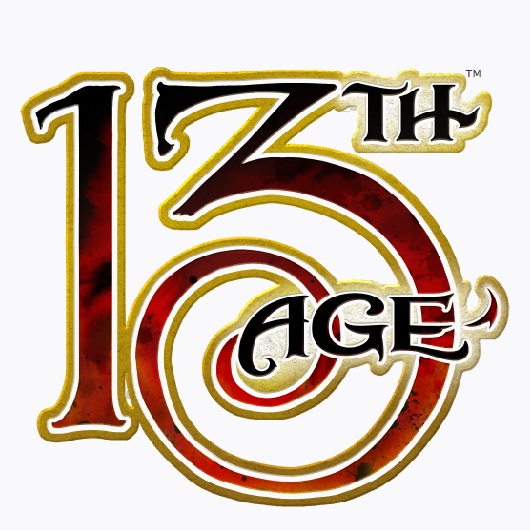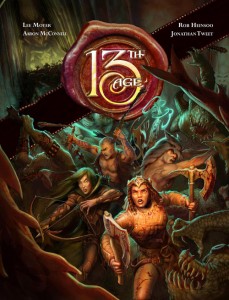by Paul Butler
If you’re a retailer looking for new lines to add to your existing selection of RPGs, you can do a lot worse than 13th Age.
The potential customer base for the 13th Age line is far greater than people looking for a new RPG to play. Here’s five simple reasons you should have the game on the shelf at your store.

It’s the perfect “third” choice for discriminating gamers
Frequently, when I am speaking with a customer who is trying to make a decision between which of the two big D20 games to play, I will briefly explain the pros and cons of each, but then with a twinkle in my eye, reveal the as-yet-unmentioned third choice. With the air of revealing a secret treasure, I will tell them how 13th Age is still the D20 game that they know and love (and here I will show them the character sheet with familiar ability names) but with the addition of some modern, almost indie-game style mechanics that drive narrative and reinforce story-driven play. One Unique Thing. Icon Relationships. The Escalation Die. These are the things that elevate 13th Age to something special and will appeal to folks who may have turned away from D20 games for more contemporary designs.
Also consider this: when asked “Star Wars or Star Trek?” there will always be those people who insist on answering “Dune.” Or when given the option of Coke or Pepsi, some folks will always prefer Dr. Pepper. Sometimes, people just want the cool “other” thing. 13th Age is how to indulge that desire.
 It’s practically a construction kit for homebrew campaign settings.
It’s practically a construction kit for homebrew campaign settings.
Many customers are simply not interested in playing in the default campaign settings of the big fantasy roleplaying games. Many players, old school gamers in particular, fondly remember the scratch-built continents and cultures from the games of their youth and want to recapture some of that magic. If they’re going to spend all that time writing or re-writing setting material, why not give them a game that is designed to help them make their own?
The Icons of 13th Age are intentionally left vague, waiting for players and GMs to put their own unique stamp on them, claiming the movers and shakers of the campaign for their own. Plus it’s rare that a party of adventurers will not include at least one player with a campaign defining One Unique Thing. 13th Age provides all manner of mechanical hooks to hang plots and story threads upon. Game Masters that prefer to create their own settings will find a great deal to like here.
But for all that, the default setting of 13th Age is superb. The Dragon Empire has enough meat that most RPG groups will be happy here for years (especially with additional material in the supplements), yet there’s enough “blank space” that every home game will be completely unique. As it should be.
It’s a great game for beginner role-players.
One look at the minimalist monster stat block or the single page character sheet and you’ll know that 13th Age is different from other D20 games. Players scared off by the veritable library of rulebooks in other game lines will find a joyful simplicity in the elegance of 13th Age. Indeed, the chapter on character classes begins with a listing of those classes in order of increasing rules complexity, so that players can choose their own speed and level of mechanical engagement.
Rules are streamlined, not dumbed-down.
And even the greenest of gamers can wrap their head around One Unique Thing and immediately find themselves invested in the experiences created at the table top.

The 13th Age rulebook is a treasure trove of ideas and mechanics that can be used in other games.
Many of the most brilliant design elements of 13th Age can be ripped out, intact, and used in other systems. Any game master can find a wide arsenal of widgets, knobs and sub-systems that be applied to other games of any genre. Beside the aforementioned One Unique Thing, Icon Relationships and Escalation Die, one will find all sorts of inspiration in a wide variety of unexpected places. At the very least, the way the game interacts with dice will have one thinking about our little multi-sided friends in whole new ways.
The Supplements
For a retailer considering bringing in the entire line of 13th Age books, it is not a daunting proposition. It’s currently only about ten products, and with price points for every customer’s budget. There’s slim affordable volumes in the form of adventure books and The Book of Loot. There’s more sizable rules additions like 13 True Ways and the 13th Age Bestiary. There’s the GM’s Screen and Resource Book. And there’s a positively massive campaign book that’s even larger than the core rulebook: Eyes of the Stone Thief. There’s plenty of variety, and yet none of the intimidating bloat of some other D20 lines.
And much like the core rulebook, there’s no reason why any of these items can’t be mined for ideas to be used for other D20 games, with or without the core rulebook. In this way, 13th Age books can almost be thought of as supplementary products to your other D20 offerings.


 It’s practically a construction kit for homebrew campaign settings.
It’s practically a construction kit for homebrew campaign settings.